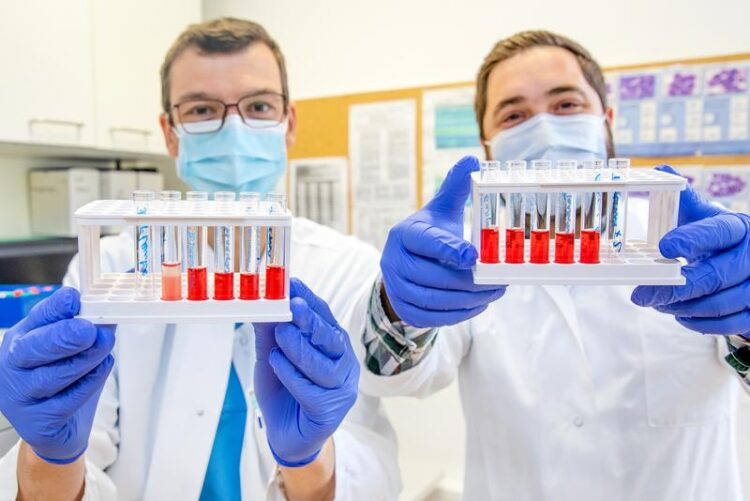New values for better diagnoses

Dr Christian Schultze-Florey and Dr Ivan Odak with blood serum samples in front of a flow cytometer.
Copyright: Karin Kaiser / MHH
MHH study develops reference tool for blood tests.
Lymphocytes belong to the white blood cells. They consist of several subgroups with different tasks in immune defence. Which and how many lymphocytes are in the blood provides information about our current state of health as well as congenital or acquired immune deficiencies. This composition in the blood can be determined precisely with the help of the most modern flow cytometry. What has been missing until now, however, were reference ranges to correctly classify the increasingly extensive measurement results of the modern devices and thus determine where the normal range ends and the disease begins.
Now, a research team led by Dr. Christian Schultze-Florey from the Department of Haematology, Haemostaseology, Oncology and Stem Cell Transplantation and Dr. Ivan Odak from the Institute of Immunology at the Hannover Medical School (MHH) has examined the blood of more than 240 healthy adults and developed new standard values that should help to reliably distinguish between sick and healthy people. The study has been published in the renowned scientific journal “Leukemia”.
New standard values for twelve lymphocyte groups
Flow cytometry is a laboratory technique that can be used to examine the different types of cells in the blood or bone marrow. While the different lymphocyte subgroups all look the same under the microscope, a modern flow cytometer can precisely distinguish the different subgroups by measuring fluorescence and even determine their activity. This is possible because the cells have previously been labelled with a coloured marker typical for them. This causes the cell to light up in a specific colour when the blood sample passes through the flow cytometer. “We used a modern standardised multicolour flow cytometry to determine the standard values for twelve lymphocyte subtypes as well as an additional 16 different activity levels of white blood cells,” explains Dr. Schultze-Florey. The blood samples came from healthy donors from the MHH Clinic for Transfusion Medicine and Tissue Engineering.
Gender and biological age taken into account
By comparing the data, the scientists were able to establish reference ranges that apply uniformly to all modern multicolour devices. “The new standard values not only differentiate according to gender, but also according to the meaningful biological age categories,” explains Dr. Odak. In contrast to biographical age, which refers to the date of birth, biological age refers to the condition of our body. Biological age can differ significantly from biographical age. “With the help of our newly established standard values, it will be possible in future to classify the findings of patients precisely,” says Dr Schultze-Florey. In this way, treating physicians can precisely evaluate the extensive measured values collected in blood tests and make an exact diagnosis. “With our study, standardised reference values are now available that can support the diagnosis of blood and immune system diseases worldwide.”
The study is a cooperation project between the Department of Haematology, Haemostaseology, Oncology and Stem Cell Transplantation and the Institute of Immunology as well as the Department of Transfusion Medicine and Tissue Engineering and was funded by the RESIST Cluster of Excellence.
SERVICE:
For further information, please contact Dr Christian Schultze-Florey, schultze-florey.christian@mh-hannover.de, telephone (0511) 532-2324.
The original paper “Distribution of major lymphocyte subsets and memory T-cell subpopulations in healthy adults employing GLP-conforming multicolor flow cytometry” can be found here: https://www.nature.com/articles/s41375-021-01348-5
Media Contact
All latest news from the category: Health and Medicine
This subject area encompasses research and studies in the field of human medicine.
Among the wide-ranging list of topics covered here are anesthesiology, anatomy, surgery, human genetics, hygiene and environmental medicine, internal medicine, neurology, pharmacology, physiology, urology and dental medicine.
Newest articles

Sea slugs inspire highly stretchable biomedical sensor
USC Viterbi School of Engineering researcher Hangbo Zhao presents findings on highly stretchable and customizable microneedles for application in fields including neuroscience, tissue engineering, and wearable bioelectronics. The revolution in…

Twisting and binding matter waves with photons in a cavity
Precisely measuring the energy states of individual atoms has been a historical challenge for physicists due to atomic recoil. When an atom interacts with a photon, the atom “recoils” in…

Nanotubes, nanoparticles, and antibodies detect tiny amounts of fentanyl
New sensor is six orders of magnitude more sensitive than the next best thing. A research team at Pitt led by Alexander Star, a chemistry professor in the Kenneth P. Dietrich…





















